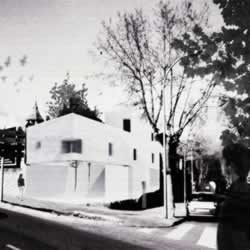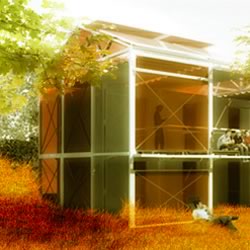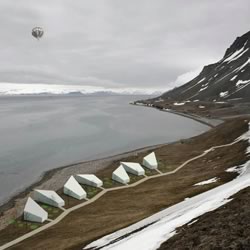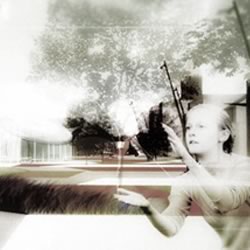Complessità urbana / Urban Complexity
Ridurre gli sprechi e usare sistemi alternativi per l’edilizia assume significati diversi a livello di progettazione urbana? Rispetto a una singola struttura, una “città efficiente” è più difficile da realizzare?
Does the reduction of wastes and the use of alternative construction systems take a different meaning if we talk of urban design? Is it harder to make a city “efficient”, than a single structure?
ARM - Quando si tratta di progettazione urbana sostenibile, dobbiamo ragionare su vari livelli e sul modo in cui tali livelli interagiscono tra loro. Su scala urbana, direi di sì: una riduzione dei rifiuti e l’uso di sistemi edilizi alternativi determinano una differenza, ma piccola. Se cambiamo il nostro modo di costruire, cambiamo il modo in cui vengono costruite le città, ma questo rappresenta solo un unico livello dell’insieme. Un edificio è un’unità statica di quell’insieme che crea una città.
Tra i singoli edifici, si colloca un livello dinamico, formato dalle infrastrutture del trasporto pubblico: strade, metropolitana, treno, etc. Dobbiamo ripensare il modo in cui muoviamo da un punto statico - la nostra casa - a un altro - il luogo di lavoro. Per esempio, potremmo aumentare la mobilità pulita, o ridurre la mobilità facilitando dinamiche di telelavoro.
Abbiamo poi il livello energetico, che collega tutti gli abitanti all’elettricità. L’accesso all’energia è considerato un diritto fondamentale, ma le implicazioni della produzione di elettricità spesso non sono oggetto di un’adeguata riflessione, mentre il danno inflitto ai territori sta diventando davvero preoccupante. Ridurre la quantità di dipendenza energetica generata da risorse non rinnovabili con metodi inefficienti è una parte cruciale nella creazione di una città sostenibile.
In sintesi, per creare una città efficiente ci sono molti livelli su cui dovremmo operare in qualità di architetti, per migliorare il suo "rendimento" e ottenere una combinazione che determini un risultato positivo. La difficoltà del paragone con la creazione di una singola struttura deriva dalla grande quantità di interazioni che una città implica e dall’esigenza che avvertiamo di costruire un senso di comunità intorno all’obiettivo della sostenibilità.
ARM: When it comes to sustainable urban design, we must speak in layers, thinking how those layers interact with each other. In an urban scale, I would say yes: a reduction of waste and the use of alternative construction systems makes a difference, but tiny. If we change the way we build, we change the way cities are built, but that is just a single layer of the whole. A building is a static unit of the whole that creates a city.
Between single buildings, we have a dynamic layer, formed by the public transport infrastructures: roads, metro, train, etc. We need to rethink the way we move from one static point - our house - to another - our office. For example, we have the possibility to Enhance clean mobility, or to reduce mobility allowing distance-work dynamics.
Then, we have the energetic layer that connects all of the inhabitants to the electricity. This is considered as a fundamental right, but the implications of the production of electricity are always far from sight, while the detriment of landscapes is getting really worrisome. Reducing the amount of power dependency generated by non-renewable resources with inefficient methods is a key part in the creation of a sustainable city.
In summary, to create an efficient city, there are many layers that we, as architects, should work on, enhancing their performance and making them create a positive result, when combined. The difficulty in comparison with creating a single structure is in the high amount of interactions that a city implies and in the necessity we feel to build a sense of community around the objective of sustainability.
MNR - Condivido l’opinione di Alejandro a proposito dei livelli differenti della città, ma penso anche che il migliore utilizzo delle risorse assuma un significato diverso su scala urbana a causa dei molti elementi che possono ostacolare la riduzione di rifiuti e l’uso di sistemi edilizi alternativi: in una dimensione estesa alla città, intervengono molti più interessi combinati (finanziatori, amministrazione cittadina, normativa, etc.), ognuno orientato al suo specifico profitto. Di conseguenza, risulta davvero difficile riuscire a convincere tutti quegli attori a cambiare e lavorare per una città “efficiente”.
MNR - I agree with Alejandro´s opinion about the different layers of the city, but I also think that in an urban scale the best use of resources has a different meaning, because there are many things that could affect the reduction of waste and the use of alternative construction systems: on a city level, many more combined interests (promoters, city hall, normative, etc.) come into play, and everyone looks for his own profit. So it’s really difficult to be able to convince all those actors to work and change for having “efficient” cities.
ACC - Sì, il tema dell’efficienza assume un significato diverso, specialmente perché differenti sono le scale di riferimento: scale globali e scale locali. In altri termini, dal satellite alle lenti. Creare una città efficiente è più impegnativo che ridurre gli sprechi di acqua e calore, e implica la realizzazione di un ambiente migliore e di uno spazio pubblico più evoluto. Attualmente, sui media circolano molte informazioni su “buone città” come Masdar, Dongtan, Songdo, Tianjin...; tuttavia, se si effettua una ricerca sugli indicatori urbani di una città “efficiente”, il risultato sarà sorprendente. Alcune delle città che sembrano molto efficienti, nella realtà si rivelano solo macchine con un tetto verde. Parametri quali coesione sociale (sicurezza, lavoro, mix sociale, attrezzature, edifici a destinazione d’uso mista); sostenibilità ( produzione di energia rinnovabile, orientamento, gestione delle acque...) e struttura urbana (densità, spazio pubblico, trasporto, occupazione, aree verdi...) sono sufficienti per sapere quanto è responsabile una città.
Avere un progetto urbano valido significa trattare una specie di componenti, o di livelli, come li ha definiti Alejandro. Le risorse fondamentali della città sono l’energia, i materiali, il territorio e, ovviamente, l’acqua. Il modo in cui si combinano determina un certo tipo di strategie urbane per una città migliore e più efficiente. Solo con un progetto urbano sostenibile si possono creare città dinamiche, rispettose sia dei cittadini, sia dell’ambiente.
ACC - Yes, efficiency takes a different meaning, specially because there are different scales: global scales and local scales. That means: from the satellite to the lens. To create an efficient city is more demanding than to reduce the waste in heat and water, and implies to achieve a better environment and a better public space. Nowadays, in the media we find a lot of information about “good cities” as Masdar, Dongtan, Songdo, Tianjin...; however, if you do a research about the urban indicators of an ‘efficient’ city you will have a surprise. In fact, some of the cities that seems very efficient are just machines with a green roof. Parameters like social cohesion (security, work, social mix, equipment-building, mixed use), sustainable issues (renewable energy production, orientation, water management...) and urban structure (density, public space, transport, occupation, green areas..) are enough to know how responsible the city is.
To have a good urban design means to deal with a sort of components, or layers, as Alejandro said . The basic resources of the city are energy, materials, territory and of course, water. Their combination of resources produces some kind of urban strategies for a better and more efficient city. Only with a sustainable urban planning design we can create dynamic cities that can be either respectful with the citizens as with the environment.






